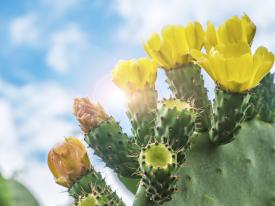Are Prickly Pear Flowers Nutritious?
Tunisian researchers provide some of the first research on nutrients in prickly pear flower species.

The fruits and spiny cladodes of prickly pear cactus have been studied quite a bit, but researchers know admittedly little about prickly pear flowers. Hoping to change that, a team of researchers in Tunisia are investigating nutritional and functional properties of flowers from two native prickly pear species, Opuntia ficus-indica and Opuntia stricta.
In drying and freezing prickly pear flowers at four different growth stages-vegetative, initial flowering, full-flowering, and post-flowering-the researchers uncovered significant amounts of protein, fiber, and fatty acids (primarily in the form of palmitic acid). Perhaps most notably, though, they also uncovered enough minerals to qualify both flower species as “excellent sources” of minerals. Flowers were richest in potassium, followed by calcium, magnesium, sodium, iron, and zinc.
The researchers detected changes in specific nutrient levels at just about every stage of the flowering process, which calls importance to the precise time at which flowers are picked. Where geographically flowers are harvested will almost certainly influence nutritional qualities, too. Functional properties of the flowers varied, too, including water solubility and oil-holding capacity.
The new research on prickly pear flowers, which can be read in full at the journal LWT–Food Science and Technology, follows a 2010 study by the same researchers which found both flower species to have remarkable antibacterial activity against pathogens S. aureus and E. coli.
For more reading on prickly pear, Ecuadorian Rainforest (Belleville, NJ) provides this summary of prickly pear fruit nutrition.
Robby Gardner
Associate Editor
Nutritional Outlook magazine
robby.gardner@ubm.com
Photo © iStockphoto.com/graffio77